Themed collection Paul R. Raithby at 70: in celebration of a life in chemistry

On the singularity of scandium
Hydrogen-bonding interactions of the [Sc2(OH)2(OH2)10]4+ dimer containing 7-coordinate Sc(III).
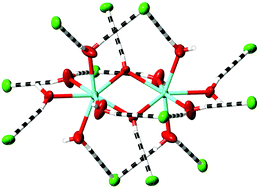
New J. Chem., 2022,46, 4003-4013
https://doi.org/10.1039/D2NJ00117A
Recent advances in externally controlled ring-opening polymerisations
Switchable catalysis is a powerful tool in the polymer chemist's toolbox as it allows on demand access to a variety of polymer architectures.

Dalton Trans., 2022,51, 1241-1256
https://doi.org/10.1039/D1DT03471E
Noncovalent n → π*, C–H⋯π, and C–H⋯O interaction mediated supramolecular assembly in a Re(CO)3(trifluoroacetate) complex bearing a bulky tetraazaphenanthrene ligand: a combined CSD study and theoretical calculations
Inspection of the X-ray structure of the newly prepared Re(CO)3(OCOCF3) complex bearing a bulky NN-donor ligand with an extended π-system revealed the role of intermolecular n → π*, C–H⋯π, and C–H⋯O interactions in the supramolecular structure of the complex.
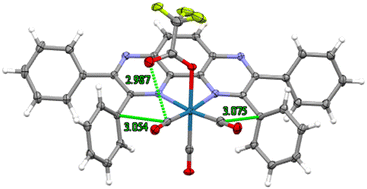
CrystEngComm, 2023,25, 1803-1816
https://doi.org/10.1039/D2CE01503J
Discerning subtle high-pressure phase transitions in glyphosate
The partitioning of volumes into ‘occupied’ and ‘unoccupied’ space can recover a spectroscopic level of sensitivity in crystallographic measurements. This has revealed structural effects of two second order high pressure phase transitions in glyphosate.
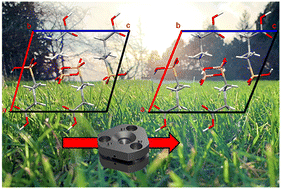
CrystEngComm, 2023,25, 988-997
https://doi.org/10.1039/D2CE01616H
Green light-emitting electrochemical cells based on platinum(II) complexes with a carbazole-appended carbene ligand
Cyclometallated N-heterocyclic carbenes with an appended carbazole and chelating diphosphines brought together to achieve the first simple solution-processed green-emitting iTMC-LECs based on mononuclear Pt(II) complexes.
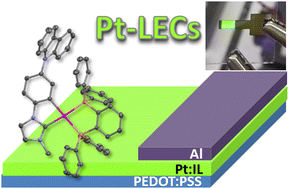
J. Mater. Chem. C, 2022,10, 15491-15500
https://doi.org/10.1039/D2TC02539F
Exploring the influence of polymorphism and chromophore co-ligands on linkage isomer photoswitching in [Pd(bpy4dca)(NO2)2]
The presence of non-innocent chromophore ligands in photoswitches can limit functionality. This photocrystallographic study shows how the negative impact of such ligands can be mitigated by control of excitation conditions, maximising photoswitching.
![Graphical abstract: Exploring the influence of polymorphism and chromophore co-ligands on linkage isomer photoswitching in [Pd(bpy4dca)(NO2)2]](/en/Image/Get?imageInfo.ImageType=GA&imageInfo.ImageIdentifier.ManuscriptID=D2CE00213B&imageInfo.ImageIdentifier.Year=2022)
CrystEngComm, 2022,24, 3701-3714
https://doi.org/10.1039/D2CE00213B
Solvatochromism and the effect of solvent on properties in a two-dimensional coordination polymer of cobalt-trimesate
A 2D coordination polymer can exchange guest species from liquid sorption, with accompanying visible colour changes.

CrystEngComm, 2022,24, 2393-2401
https://doi.org/10.1039/D2CE00039C
Synthesis, structures and properties of metal–organic frameworks prepared using a semi-rigid tricarboxylate linker
A series of MOFs constructed from 5-((carboxymethyl)amino)isophthalic acid (H3cmai) have been prepared and characterised, with [Cd3(cmai)2(H2O)4]·4H2O demonstrating loss of water in a single-crystal-to-single-crystal transformation.
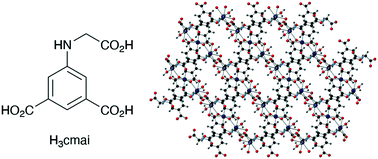
CrystEngComm, 2022,24, 863-876
https://doi.org/10.1039/D1CE01284C
Synthesis, characterization, and optoelectronic properties of phenothiazine-based organic co-poly-ynes
We present the synthesis of seven new organic co-poly-ynes P1–P7 incorporating phenothiazine (PTZ) motif and evaluate their optoelectronic properties and performance in polymer light-emitting diodes (PLEDs) and polymer solar cells (PSCs).
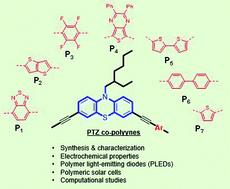
New J. Chem., 2021,45, 15082-15095
https://doi.org/10.1039/D1NJ00925G
Using geometric simulation software ‘GASP’ to model conformational flexibility in a family of zinc metal–organic frameworks
Synthesis with different solvents leads the same metals and ligands to assemble into geometrically and topologically distinct frameworks, aided by intrinsic flexibility of the ligand.

New J. Chem., 2021,45, 8728-8737
https://doi.org/10.1039/D1NJ01158H
Electronic and steric effects of platinum(II) di-yne and poly-yne substituents on the photo-switching behaviour of stilbene: experimental and theoretical insights
Synthesis of Pt(II) mono-, di-, and poly(platina-ynes) incorporating stilbene is described and their photoisomerization has been investigated and compared with azobenzene counterparts.
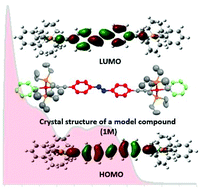
Dalton Trans., 2021,50, 2555-2569
https://doi.org/10.1039/D0DT03502E
Utilization of a Pt(II) di-yne chromophore incorporating a 2,2′-bipyridine-5,5′-diyl spacer as a chelate to synthesize a green and red emitting d–f–d heterotrinuclear complex
The heteronuclear trimetallic d–f–d complex [Eu(btfa)3{(Ph)(Et3P)2Pt–C![[triple bond, length as m-dash]](https://www.rsc.org/images/entities/char_e002.gif) C–R–C
C–R–C![[triple bond, length as m-dash]](https://www.rsc.org/images/entities/char_e002.gif) C–Pt(Et3P)2(Ph)}] has been synthesized and characterized spectroscopically. The complex displays both red and green emissions in solution.
C–Pt(Et3P)2(Ph)}] has been synthesized and characterized spectroscopically. The complex displays both red and green emissions in solution.
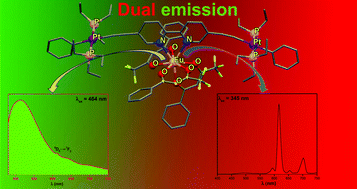
Dalton Trans., 2021,50, 1465-1477
https://doi.org/10.1039/D0DT04198J
Towards white light emission from a hybrid thin film of a self-assembled ternary samarium(III) complex
A new samarium(III) complex, [Sm(hfaa)3(Py-Im)], has been prepared and fabricated into thin films which show color tunability from violet to orange depending on the concentration of doping within the film.

New J. Chem., 2020,44, 5673-5683
https://doi.org/10.1039/C9NJ06287D
Exploring short strong hydrogen bonds engineered in organic acid molecular crystals for temperature dependent proton migration behaviour using single crystal synchrotron X-ray diffraction (SCSXRD)
Short strong hydrogen bonds in multi-component organic acid molecular crystals exhibit temperature dependent proton migration for certain HB donor–acceptor distances.
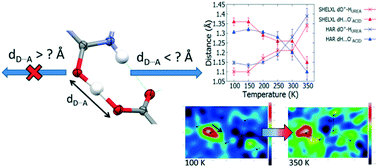
CrystEngComm, 2019,21, 5249-5260
https://doi.org/10.1039/C9CE00925F
Further studies of the Enhanced Structural Carborane Effect: tricarbonylruthenium and related derivatives of benzocarborane, dihydrobenzocarborane and biphenylcarborane
{Ru(CO)3} derivatives and related compounds of benzocarborane, dihydrobenzocarborane and biphenylcarborane have been prepared and characterised.

Dalton Trans., 2016,45, 11742-11752
https://doi.org/10.1039/C6DT01888B
On the mechanisms of fluxionality and isomerisation of [Fe3(CO)12–n{P(OMe)3}n](n= 1–3)
About this collection
Professor Paul Raithby is an Emeritus Professor of Inorganic and Structural Chemistry at the University of Bath. Paul obtained a B Sc Degree in Chemistry (1973) from Queen Mary University, London, and remained there to study for a PhD (1976) in structural chemistry under the supervision of Professor Mike Hursthouse working on silylamine complexes with Professor Don Bradley’s group. He then moved to Cambridge (1976) initially for a post-doctoral post with Professor Lord Lewis FRS and Professor Brian Johnson FRS, determining the structures of cluster carbonyl complexes in collaboration with Professor George Sheldrick FRS. Upon the completion of his post-doc he joined the faculty in Cambridge, and was subsequently appointed to a lectureship (1994) and then a readership (1998). He was also elected to a Fellowship at St Catharine’s College where he served as Director of Studies for Chemistry and was a college tutor. In 2000 he moved to the Chair of Inorganic Chemistry at the University of Bath, where he developed his interest in photo-crystallography exploiting the single-crystal facilities at the Daresbury synchrotron. He has continued to pioneer the use of synchrotron radiation in single-crystal X-ray diffraction studies for the remainder of his career and contributed to the design of the single-crystal X-ray station at the Diamond Synchrotron.
Paul continues to pursue his interests in organometallic and coordination chemistry through studies on photoactivated solid-state transformations and in establishing structural trends using knowledge mining techniques with data from structural databases and continues to be an inspiration to all who know him.
To date, Paul has published over 940 papers, the majority in RSC journals, including over 200 in Dalton Transactions alone. This special web collection, marking Paul’s 70th birthday and his retirement, brings together work from and inspired by his extraordinary career. These papers reflect Paul’s wide-ranging interests and propensity to inspire those around him.
Andrew L. Johnson February 2022.